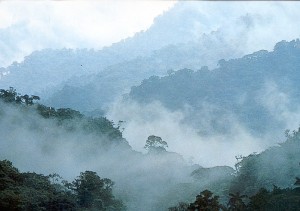Cloud forests are very interesting scientifically. I would like to focus more on the science behind what a cloud forest is and how climate change can and does impact these areas. I am including a plethora of resources along with the quotes I would like to incorporate into the project.
Outline for the field: I would like to learn more about the climatological impacts that are obvious enough for people to see. That way I can couple scientific and observational evidence to further strengthen the research of this project.
Reference: http://www.monteverdecostarica.com
Quotes:
“A cloud forest is a highland forest characterized by nearly 100% humidity throughout the year. Here in Monteverde, warm North-Easterly trade winds, filled with moisture, blow in over the Atlantic. As the winds sweep up to the Continental divide, they cool and condense to form clouds, bathing the forest in a constant soft mist. The Monteverde cloud forest receives an incredible four meters of rain every year- that is almost twelve feet.”
Paraphrased:
A cloud forest is characterized by nearly 100% humidity year-round. It maintains this environment through the trade winds coming off the Caribbean that ascent the mountains, forming clouds that are fairly consistent all year long. This increases the precipitation seen in the area drastically, with the cloud forest receiving almost twelve feet of rain every year.
_____________________
Reference: http://www.reservamonteverde.com
Quotes:
- Monteverde houses 2.5% of worldwide biodiversity.
- 10% of its flora is endemic.
- Costa Rica represents the 0.03% of the landmass of the planet and has the 5% of the Biodiversity of the world.
- One of the best examples of sustainable tourism that you can experience.
“Monteverde Cloud Forest Biological Reserve’s climate is strongly influenced by air currents saturated with moisture that flow into the country from the northeast (trade winds). As you climb the Tilarán Mountain Range, orographic precipitation occurs as a result of the cooling it undergoes, or fog, which characterizes the main cloud forest in the area. These conditions produce a noticeable tropical rainy climate, where the seasonal variation in temperature and rainfall is minimal; both remain high throughout the year.”
“the warmest months are April with a temperature of 23.7 ° C and May with a temperature of 23.4 ° C, while the coldest months are January with a temperature of 13.9 ° C, and February with a temperature of 13.8 ° C. The average annual temperature is 18.8 ° C. As for precipitation, the institute reported an annual average of 2,579 mm. September and October are the with the most rain (405 mm and 428.6 mm respectively), and March and April, with the least rain (34 , 6 mm and 49.7 mm respectively).”
Paraphrased:
Costa Rica makes up a small land area but alone houses a large percentage of the world’s biodiversity (5%). The climate of Costa Rica is warm year-round, and this gives way to a tourist hotspot. Costa Rica has taken advantage of this in a way that helps to sustain its biodiversity and at the same time bring in revenue for the country.
_____________________
Reference: http://www.monteverdeinfo.com/monteverdes-cloud-forests.html
Quotes:
(about Santa Elena Reserve) –> “A cloud forest is a high-elevation forest characterized by a persistent, canopy-level cloud cover. These clouds provide the forest with a continual supply of moisture, which supports the fantastic array of plants that live here.
Warm winds from the Atlantic Ocean sweep over the Continental Divide, cooling and condensing to form clouds as they rise. By the time they reach Santa Elena, the clouds are thick and filled with moisture. The forest is thus bathed in a constant supply of mist, which, over the course of a year, amounts to nearly twelve feet of rain.
Not surprisingly, the Monteverde cloud forest is abundant with vegetation. The competition for growing space is so intense that the trunks, branches and even roots of trees are almost entirely covered with other plants – epiphytes, lichens, liverworts, bryophytes, mosses and more. Strong winds and water-laden limbs often cause branches to break and fall to the ground. This not only creates light gaps in the canopy, but also provides the forest floor with added nutrients.”
“Often taking the form of fog, these clouds hover around the upper canopy of the forest before condensing onto the leaves of trees and dripping onto the plants below.
Understandably, the sun has a hard time breaking through this thick veil of clouds. This causes a slower rate of evaporation and thus provides the plants with a bounty of life-giving moisture. This moisture helps to promote a huge amount of biodiversity”
“Cloud forests also tend to host a large number of endemic species, as their unique climates and specialized ecosystems create habitats that are not found anywhere else on Earth.”
“Climate change is expected to seriously alter the nature of these forests. Models suggest that the low-level cloud coverage will be reduced, and as a result, temperatures will go up. This could cause the forests’ hydrological cycle to change and potentially even dry up. This alarming theory gives traveler’s all the more reason to act in environmentally responsible ways both at home and abroad.”
Paraphrased:
The climate of the cloud forest is consistent enough with moisture that a large abundance of plant life is able to sustain itself in these areas. Plant life is so abundant, there are actually species that live directly on other species. The thickness of cloud cover reduces the rate of evaporation and confines moisture to the area. This also keeps the climate warm, because evaporation is a cooling process. This gives way to a warm, moist climate that is conducive for the large amount of biodiversity found in these areas.
Unfortunately for the cloud forests, however, climate change has a huge impact on this cloud cover. Even minimal changes could affect a large number of species.


